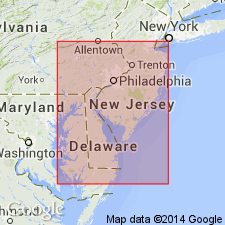
- Usage in publication:
-
- Van Sciver Lake beds*
- Modifications:
-
- First used
- Dominant lithology:
-
- Gravel
- Sand
- Silt
- AAPG geologic province:
-
- Atlantic Coast basin
Summary:
The "Trenton Gravel" is subdivided into the Spring Lake beds and Van Sciver Lake beds. Spring Lake beds (graywacke 2 of Owens and Minard, 1975) have surface altitudes of 10.4-21 m and are present in the upper reaches of the lowland subprovince between Trenton, NJ, and Philadelphia, PA. Most of these deposits are within the Delaware River valley. Exposures of the Van Sciver Lake beds (Graywacke 1 of Owens and Minard, 1975) are few because most of the unit is deeply buried. The best outcrops are in excavations in the upper Delaware River valley, particularly at Van Sciver Lake. The coarse gravel and sand within this unit are similar to those in the beds at Spring Lake. Downvalley the gravel content declines and the unit is mostly interbedded, thick-bedded clay-silt and cross-bedded sand. Biostratigraphic dating and the crosscutting relationship with the Spring Lake beds suggests a late Sangamonian age. Fig. 40 shows beds extending to DE along the Delaware Bay.
Source: GNU records (USGS DDS-6; Reston GNULEX).
For more information, please contact Nancy Stamm, Geologic Names Committee Secretary.
Asterisk (*) indicates published by U.S. Geological Survey authors.
"No current usage" (†) implies that a name has been abandoned or has fallen into disuse. Former usage and, if known, replacement name given in parentheses ( ).
Slash (/) indicates name conflicts with nomenclatural guidelines (CSN, 1933; ACSN, 1961, 1970; NACSN, 1983, 2005, 2021). May be explained within brackets ([ ]).

